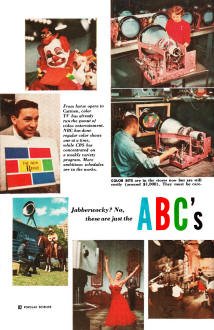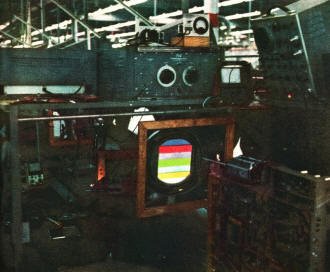|
July 1954 Popular Science
 [Table of Contents] [Table of Contents]
Wax nostalgic about and learn from the history of early
electronics. See articles from
Popular
Science, published 1872-2021. All copyrights hereby acknowledged.
|
This 1954 Popular
Science magazine piece on "The ABC's of Color Television" is useful, but it
is strange that a labeled picture of the composite video signal is not provided
to go along with the definitions of the various parts of it (front porch, back
porch, red/green/blue video, color killer for black & white signals, I, Q and Y
signals, etc. ). Nor is there a labeled picture of any of the components of a
color TV (CRT, deflection coils, horizontal and vertical sync controls, hue and
brightness controls, etc.). Of course in 1954 not many people had ever even seen
a color television set, much less make adjustments on one. It wasn't until
around 1965 that most Prime Time shows were broadcast in color. The first
commercial color television broadcast occurred in 1954 during the Tournament of
Roses Parade. Price was a major deterrent since a typical cost in equivalent
2024 money was around $5,000!
ABC's of Color Television

From horse opera to Carmen, color TV has already run the gamut of video entertainment.
NBC has done regular color shows one at a time, while CBS has concentrated on a
weekly variety program. More ambitious schedules are in the works.
Jabberwocky? No, these are just the ABC's of Color Television
You, too, can tell a matrix from a killer with this glossary of the strange jargon
that color TV is adding to our language.
By Martin Mann
Ghost, snow and channel do not necessarily refer, anymore, to the supernatural,
precipitation or waterways. Television has given these words new meanings. And more
such changes in our language are coming, for color TV brings its own lively jargon.
Some are new words, others just new meanings. But all are fun to know - and help
show how this latest miracle of electronic entertainment is achieved.
Additive: Colors are created on a television screen by adding
together different proportions of primary-colored lights. Red light plus green light
gives yellow, for example. The lights are tiny dots of glowing colored phosphors
on the face of the tube. This additive method is the opposite of the subtractive
one used on magazine covers. There, pigments subtract various parts from white light
to create the desired shade.
Back Porch: Part of the color TV wave that carries the color
sync signal, which synchronizes receivers with the transmitter.
Chroma Control: The knob that lets you adjust the vividness,
or saturation, of the color picture. It doesn't alter the actual brightness of the
image, or change colors, but will vary the intensity from pale pastels to deep shades.
Decoder: The primary-colored lights on the viewing screen that
create the color image are controlled by primary-colored signals (red, green and
blue). These, however, are not transmitted as such in the color TV wave. Instead
they are scrambled into a code. It is the job of the decoder circuits in the receiver
to unscramble the wave into the red, green and blue signals that the picture tube
needs.

Color Sets are in the stores now but are still costly (around $1,000). They must
be carefully checked, as shown at left above in Westinghouse's Metuchen, N.J.,
factory. Vertical-bar lest pattern shows up horizontal (above) because receiver
is on its side.
Electron Gun: The phosphors on a viewing screen glow when struck
by electrons, which come from a gun located at the other end of the picture tube.
Frequency Interlace: The color TV wave carries about twice the
load - information - that the black-and-white wave has. Yet it must fit into the
same radio space-band width. This is accomplished by frequency interlace: the color
signals are interleaved into spaces left empty in a black-and-white wave.
Green Video Voltage: The signal coming from the green camera
tube or going to the green gun in the viewing tube. It corresponds to the' green
part of the picture.
Hue Control: A receiver knob that helps keep red red, green
green, and so on. It sets only the basic color and does not affect shading or brightness.
I Signal: One of the three signals in the color-television wave
as it is actually transmitted through the air. It is a code made by mixing certain
proportions of the red, green and blue signals from the camera. It contains information
needed to reproduce colors ranging from bluish green to orange.
Jack: Socket on electronic equipment for plugging in test instruments
or accessories.
Killer: Color sets can also receive black-and-white shows, but
to do so properly their color circuits must be switched off. The killer tube does
this automatically, being triggered when the incoming wave lacks a color sync signal.
Luminance: Technical term for brightness - how light or dark
(not how pale or deep in color) the picture is.
Matrix: A circuit in the camera that mixes the red, green and
blue signals from the camera tubes to create the I, Q and Y code signals to be sent
through the air. A similar matrix in the receiver unscrambles the I, Q and Y signals
back into the red, green and blue signals for the viewing tube.
NTSC: National Television System Committee, the electronics-industry
group that worked out and gave its name to the present color-television standards.
Oscillator, Subcarrier: A precisely controlled circuit in the
receiver that governs the handling of the color signals.
Purity Coils: Electromagnets on the color-picture tube that
keep the three electron beams aimed correctly. Even a slight misalignment would
cause the beams to hit the wrong color phosphor dots on the viewing screen, since
these are very tiny and very close together. The result might be a green sky and
red grass.
Q Signal: One of the three signals in the color television wave
as sent through the air. It is a mixture of the red, green and blue signals from
the camera and contains information needed to reproduce yellowish green to purple.
Red Video Voltage: The signal coming from the red camera tube
or going to the red gun of the receiver picture tube. It corresponds to the red
part of the image.
Saturation: Technical term for vividness of a color - scarlet
is more saturated than pink, for example, although both are the same hue (red) and
could be the same brightness. The chroma control on the color receiver adjusts saturation.
Three-Gun Tube: Most of the color picture tubes now being made
have three electron guns, one for each primary col-or. Single-gun tubes are also
being developed.
UHF: A band of TV frequencies, recently authorized, with 70
channels and ranging from 470 to 890 megacycles.
VHF: A band of television frequencies, in use since 1946, containing
channels 2 through 13 and ranging from 54 to 216 megacycles.
White Level: Part of the television wave that limits the "whitest"
white the picture can reproduce. The black level sets a similar limit to the "blackest"
black.
XMTR: Abbreviation for transmitter.
Y Signal: One of the three signals in the color-television wave
as sent through the air. It is a mixture of the red, green and blue camera signals,
but so proportioned that it contains brightness information rather than color information.
It is almost identical to the standard black-and-white TV signal. When ordinary
black-and-white receivers are tuned to a color telecast, they use the Y signal (disregarding
the I and Q signals ) to reproduce an excellent black-and-white image of the color
picture. This is what makes the system compatible.
Zero Reference: A point from which measurements are made. The
color sync signal, for example, is zero reference for setting the I and Q signals.
Posted January 19, 2024
|









